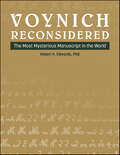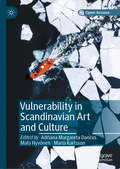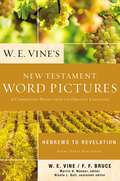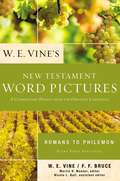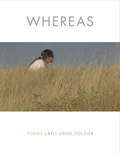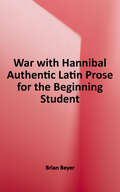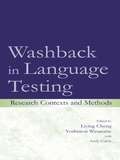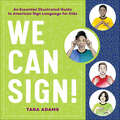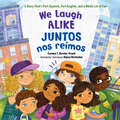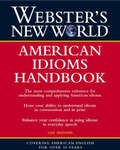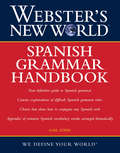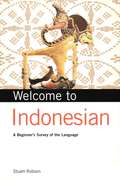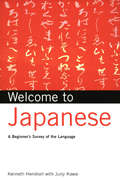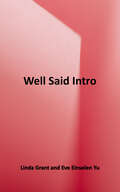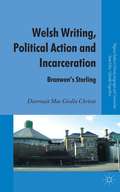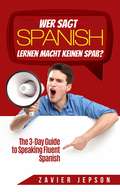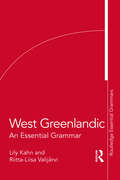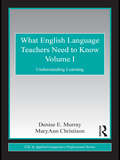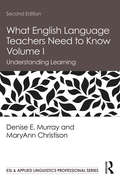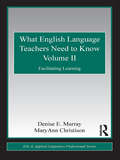- Table View
- List View
Vox Latina
by W. Sidney AllenThis is a reissue in paperback of the second edition of Professor Allen's highly successful book on the pronunciation of Latin in Rome in the Golden Age. In the second edition the text of the first edition is reprinted virtually unchanged but is followed by a section of supplementary notes that deal with subsequent developments in the subject. The author also added an appendix on the names of the letters of the Latin alphabet and a select bibliography.
Voynich Reconsidered: The Most Mysterious Manuscript in the World
by Robert H. EdwardsIn this book, Dr. Robert Edwards brings a fresh, mathematical perspective to the Voynich manuscript and sets out a strategy whereby the interested reader could extract meaning from the seemingly impenetrable symbols . . . if meaning is there to be found. The Voynich manuscript has been described as the most mysterious document in the world. In 1637, a Bohemian scholar sent a mysterious manuscript to the celebrated professor Athanasius Kircher in Rome. Kircher promised to decipher it when the mood took him. He never did. Later, antiquarian bookseller Wilfrid Voynich claimed that he had discovered it in 1912 in a castle in Europe. • Contains hundreds of bizarre illustrations that seem to represent plants, stars, animals, zodiac signs, strange receptacles, and naked women in pools and streams of green water. • Throughout its over 200 pages are strings of glyphs or symbols that look like words; but the symbols do not belong to any known living or extinct languages. • No one knows what these symbols mean—or even whether they mean anything, though hundreds of scholars have tried to decipher them for 500 years. • Today, all that we know for sure is that the parchment probably dates from the early 15th century.
Vredaman
by Unai Elorriaga Lopez de LetonaAurreko bere bi liburu arrakastatsuen ondoren (Sprako tranbia eta Van?t Hoffen ilea), nobela berri batekin dator Unai Elorriaga (Algorta, 1973): Vredaman. Aita ospitalean gaixo eta ama hura zaintzen dauzkalako osaba-izekoen etxera bidaltzen duten haurra; golf-klub baten barruan errugbi-zelai klandestino bat margotu nahi duten bi lagun; urtetan arkitekto baten andregai izan baina inoiz ezkondu ez zen emakume adindua; aitite gizon inportantea zela jakin eta haren arrastoaren atzetik dabilen gaztea. Elkarrekin nahasten diren hainbat istorio daude liburu honetan, pertsonaia ameslari, xelebre edo maitagarriz beteak, bakoitza bere estilo eta hizkera berezian kontatua: haurraren sinpletasun magikoa, atso-agureen berritsukeria patxadatsua, alprojen elkarrizketa zoroak? Jolasetik asko du eleberri honek, baina jolasetik harago gizatasun-taupadak ere nabarmenduko ditu irakurleak, amaierara hurbildu ahala emozioan goraka doan kontakizun biribil eta gozagarri honetan.
Vulnerability in Scandinavian Art and Culture
by Mats Hyvönen Adriana Margareta Dancus Maria KarlssonIn this open access book, seventeen scholars discuss how contemporary Scandinavian art and media have become important arenas to articulate and stage various forms of vulnerability in the Scandinavian welfare states. How do discourses of privilege and vulnerability coexist and interact in Scandinavia? How do the Scandinavian countries respond to vulnerability given increased migration? How is vulnerability distributed in terms of margin and centre, normality and deviance? And how can vulnerability be used to move audiences towards each other and accomplish change? We address these questions in an interdisciplinary study that brings examples from celebrated and provocative fiction and documentary films, TV-series, reality TV, art installations, design, literature, graphic art, radio podcasts and campaigns on social media.
W. E. Vine's New Testament Word Pictures: A Commentary Drawn from the Original Languages
by W. E. VineStudy the meaning of biblical words in the original languages without spending years learning Greek. W. E. Vine's New Testament Word Pictures places every key word from Vine's classic Expository Dictionary of New Testament Words in Bible book and verse-by-verse order. The text of the King James Version of the Bible is included for context, but W. E. Vine's New Testament Word Pictures is keyed to the Strong's numbering system and can be used with any Bible translation.W. E. Vine's New Testament Word Pictures:Explains key words in original Greek contextDoes not require knowledge of GreekIncludes Strong's numbers for further studyIs ideal for busy Bible preachers and teachersCombines the features of a dictionary, concordance, and commentary
W. E. Vine's New Testament Word Pictures: A Commentary Drawn from the Original Languages
by W. E. VineStudy the meaning of biblical words in the original languages without spending years learning Greek.W. E. Vine's New Testament Word Pictures places every key word from Vine's classic Expository Dictionary of New Testament Words in Bible book and verse-by-verse order. The text of the King James Version of the Bible is included for context, but W. E. Vine's New Testament Word Pictures is keyed to the Strong's numbering system and can be used with any Bible translation.W. E. Vine's New Testament Word Pictures:Explains key words in original Greek contextDoes not require knowledge of GreekIncludes Strong's numbers for further studyIs ideal for busy Bible preachers and teachersCombines the features of a dictionary, concordance, and commentary
WHEREAS: Poems
by Layli Long SoldierThe astonishing, powerful debut by the winner of a 2016 Whiting Writers' AwardWHEREAS her birth signaled the responsibility as mother to teach what it is to be Lakota therein the question: What did I know about being Lakota? Signaled panic, blood rush my embarrassment. What did I know of our language but pieces? Would I teach her to be pieces? Until a friend comforted, Don’t worry, you and your daughter will learn together. Today she stood sunlight on her shoulders lean and straight to share a song in Diné, her father’s language. To sing she motions simultaneously with her hands; I watch her be in multiple musics.—from “WHEREAS Statements”WHEREAS confronts the coercive language of the United States government in its responses, treaties, and apologies to Native American peoples and tribes, and reflects that language in its officiousness and duplicity back on its perpetrators. Through a virtuosic array of short lyrics, prose poems, longer narrative sequences, resolutions, and disclaimers, Layli Long Soldier has created a brilliantly innovative text to examine histories, landscapes, her own writing, and her predicament inside national affiliations. “I am,” she writes, “a citizen of the United States and an enrolled member of the Oglala Sioux Tribe, meaning I am a citizen of the Oglala Lakota Nation—and in this dual citizenship I must work, I must eat, I must art, I must mother, I must friend, I must listen, I must observe, constantly I must live.” This strident, plaintive book introduces a major new voice in contemporary literature.
Walker's Rhyming Dictionary of the English Language
by J. WalkerFirst published in 1983.This is a long-established standard work of reference for poets and rhymesters.
War With Hannibal: Authentic Latin Prose for the Beginning Student
by Brian BeyerThis edition of Book III of Eutropius's Breviarium ab urbe condita is designed to be a student's first encounter with authentic, unabridged Latin prose. Written in a simple and direct style, the Breviarium covers the period of Roman history that students find the most interesting—the Second Punic War fought against Carthage—and the original Latin text is supplemented with considerable learning support. Full annotations on every page, detailed commentary on grammar and syntax, and a glossary designed specifically for the text allow students to build both their confidence and their reading skills. <p><p>The commentary in the back of the book is cross-referenced to the following commonly used textbooks: <p>• Wheelock's Latin, 6th Edition <p>• Latin: An Intensive Course by Moreland and Fleischer <p>• Ecce Romani II, 3rd Edition - Latin for Americans, Level 2 <p>• Jenney's Second Year Latin <p>• Allen and Greenough's New Latin Grammar <p><p>Macrons have been added to the entire text in accordance with the vowel quantities used in the Oxford Latin Dictionary. Additional resources include an unannotated version of the text for classroom use, supplementary passages in English from other ancient authors, and appendixes with a timeline of events and maps and battle plans. <p><p>The text may be used in secondary schools and colleges as early as the first year of study. The copious translation help, notes, and cross-references also make it ideal for independent learners.
Washback in Language Testing: Research Contexts and Methods
by Andy Curtis Liying Cheng Yoshinori WatanabeWashback refers to the influence of language testing on teaching and learning. This volume, at the important intersection of language testing and teaching practices, presents theoretical, methodological, and practical guidance for current and future washback studies. In the field of language testing, researchers' major interest has traditionally been focused on issues and solving problems inherent in tests in order to increase their reliability and validity. However, the washback effect goes well beyond the test itself to include factors, such as curriculum, teacher and learner behaviors inside and outside the classroom, their perceptions of the test, and how test scores are used. Only recently have researchers started to empirically investigate the phenomenon of washback. This volume of such research serves two essential purposes by:*providing an overview of the complexity of washback and the various contextual factors entangled within testing, teaching, and learning; and *presenting empirical studies from around the world that offer insights into the effects of washback in specific educational contexts and models of research on which future studies can be based. The extensive use of test scores for various educational and social purposes in society nowadays makes the washback effect a high-interest phenomenon in the day-to-day educational activities of teachers, researchers, program coordinators/directors, policymakers, and others in the field of education. Washback in Language Testing: Research Contexts and Methods is a valuable resource for those who are interested in the application of findings to actual teaching and learning situations or conduct washback research in their own contexts, including educational and psychological testing experts, as well as alternative assessment people in all fields, and for policy- and decision-makers in educational and testing organizations.
We Can Sign!: An Essential Illustrated Guide to American Sign Language for Kids
by Tara AdamsEasy signing is in your hands—an illustrated guide for kids ages 8 to 12Discover how simple learning sign language for kids can be! Whether it's for reaching out to a Deaf person, chatting with friends across a crowded room, or just learning an amazing new language, We Can Sign! is an essential guide to getting started with American Sign Language for kids.Bursting with almost 200 fully-illustrated signs, memory tips, and more, this instructional aid for sign language for kids makes mastering ASL easy. Ten chapters take you all the way from sign language basics and conversation phrases to must-have vocab. Get signing today!We Can Sign! An Essential Illustrated Guide to American Sign Language for Kids includes:Up-to-date info—Learn the most modern version of American Sign Language—while also getting fun insight into Deaf culture.Clear illustrations—Start signing fast with detailed drawings that show exactly how each sign should look.182 signs you need—Lessons begin simple and progress to more advanced ideas as you learn words and phrases that are perfect for use in a variety of situations.Get a helping hand with this fully illustrated guide to sign language for kids!
We Laugh Alike / Juntos nos reímos: A Story That's Part Spanish, Part English, and a Whole Lot of Fun
by Carmen T. Bernier-GrandSix kids are ready to play: three speak English. Y tres hablan español [and three speak Spanish]. But all of them laugh alike and together! This clever playground adventure weaves together bilingual Spanish and English conversations, so two groups of children can express similar thoughts in their own languages.A brand new barrier-breaking and friendship-affirming bilingual picture book from award-winning author Carmen T. Bernier-Grand (Diego: Bigger than Life). Three kids are playing at the park when three more arrive. The groups can't understand each other because one trio speaks only English and the other only Spanish. But they can express similar thoughts in their own languages. Aquí interactúan el inglés y el español. Can they find a way to play? Of course they can! By watching each other, both groups learn that they are more alike than different and end up discovering new words and making new friends in this adventure propelled by clever integrated Spanish dialogue.
Webster's New World: American Idioms Handbook (Webster's New World)
by Gail BrennerThe most comprehensive reference for understanding and using the contemporary idioms of American English—with more than 1,000 entries. Mastering the use of idiomatic language is an essential step toward achieving fluency in any language. Webster's New World: American Idioms Handbook is the ideal guide to the slang, sayings, expressions, jargon, and colloquialisms of American English—covering more than 1,000 entries. Emphasizing acquisition and application, this book explains their meanings as well as when, where, why, and how to use them. A wealth of examples helps readers understand each idiom&’s connotation and identify its appropriate context. An extensive index allows for quick and easy reference.
Webster's New World: Spanish Grammar Handbook (Webster's New World)
by Gail SteinThis definitive guide to Spanish grammar covers all aspects of spoken and written Spanish from essential vocabulary to tense and mood conjugations. Webster&’s New World: Spanish Grammer Handbook is an essential resource for any Spanish language learner. Divided into fifteen chapters, it covers everything from basic necessities such as numbers, dates, and weather, to more complex forms of expression such as comparisons, idioms, and the subjunctive mood. Covering vocabulary, conjugation, tenses, moods, and much more, this complete guide will help you hone your Spanish speaking and writing skills. Organized so you can proceed at your own pace and review as needed, Webster's New World Spanish Grammar Handbook helps you progress from vocabulary to proficiency so you can communicate confidently in both social and business situations.
Welcome to Indonesian
by Stuart RobsonThis is a concise and user-friendly introduction to the Indonesian languageThis concise book aims to introduce the reader to the Indonesian language not by creating a course, with grammar and exercises, but by describing it from various points of view, such as telling what it is related to and how it has developed, and on this basis saying where some of its words originate, as a means of familiarization with some common examples. After that, the description moves on to talk about the kinds of words one wold expect to meet, and how they can be put together as sentences, before providing a few examples of journalistic prose as well as some more literary specimens, in order to give a feeling for the language. Welcome to Indonesian includes:Chapter 1: What is Indonesian?Chapter 2: Bahasa Indonesia as the National LanguageChapter 3: A Historical OverviewChapter 4: The Development of Modern IndonesianChapter 5: Indonesian and MalaysianChapter 6: The colloquial Dimension, Influence of Dialek JakartaChapter 7: What is Indonesian Related to?Chapter 9: Loanwords in Indonesian Chapter 10: The Indonesian WordChapter 11: The Indonesian SentenceChapter 12: Journalistic ProseChapter 13: A Literary DimensionSuggestions for Further ReadingGlossary of Indonesian Words
Welcome to Indonesian
by Stuart RobsonThis is a concise and user-friendly introduction to the Indonesian languageThis concise book aims to introduce the reader to the Indonesian language not by creating a course, with grammar and exercises, but by describing it from various points of view, such as telling what it is related to and how it has developed, and on this basis saying where some of its words originate, as a means of familiarization with some common examples. After that, the description moves on to talk about the kinds of words one wold expect to meet, and how they can be put together as sentences, before providing a few examples of journalistic prose as well as some more literary specimens, in order to give a feeling for the language. Welcome to Indonesian includes:Chapter 1: What is Indonesian?Chapter 2: Bahasa Indonesia as the National LanguageChapter 3: A Historical OverviewChapter 4: The Development of Modern IndonesianChapter 5: Indonesian and MalaysianChapter 6: The colloquial Dimension, Influence of Dialek JakartaChapter 7: What is Indonesian Related to?Chapter 9: Loanwords in Indonesian Chapter 10: The Indonesian WordChapter 11: The Indonesian SentenceChapter 12: Journalistic ProseChapter 13: A Literary DimensionSuggestions for Further ReadingGlossary of Indonesian Words
Welcome to Japanese: A Beginners Survey of the Language
by Kenneth G. Henshall Junji KawaiThis is a concise and user-friendly introduction to the Japanese language.<P><P>Japanese has too often been treated by Westerners as an exotic curiosity, but the reality is that it is a functional language spoken as a mother tongue by more than 125 million people, and ranks as the ninth most spoken language in the world. In the present global age, an age characterized by a vast range of Japanese products including electronic games and anime, more and more Westerners are in one way or another interacting with Japan and Japanese people. But it is nonetheless fair to say that the language, while increasing in popularity as a subject of study, is still not as widely spoken among non-Japanese as we might expect.In this book we would therefore like to "demistify" Japanese, to show how the language is formed and used, and to encourage you to pursue the study of it. Of course it has its challenges, especially with regards to the writing system, but we try to put these in a balanced context. And we like to think that, by describing the various facets of the Japanese language to you, we thereby empower you with a degree of knowledge and familiarity.
Well Said Intro (Well Said, New Edition Series)
by Linda Grant Eve Einselen YuThe Well Said series is designed to improve the pronunciation and communication skills of beginner to advanced students from all language backgrounds. It offers a clear course plan covering the essential areas of pronunciation, including stress, rhythm, and intonation--features that research shows help students the most. Additionally, there are over fifty pages of supplemental activities focusing on consonant and vowel sounds. The Intro level of Well Said is a slower-paced course that introduces the most important pronunciation features at the beginning to low-intermediate level. A free Website for teachers and students includes the full audio program.
Welsh Writing, Political Action and Incarceration: Branwen’s Starling (Palgrave Studies in Minority Languages and Communities)
by Diarmait Mac Giolla ChríostWelsh Writing, Political Action and Incarceration examines the prison literature of certain iconic Welsh authors whose political lives and creative writings are linked to ideas about Wales and the Welsh language, the nature of political activism, and the function of incarceration.
Wer sagt Spanisch lernen macht keinen Spaß?
by Zavier JepsonSuchen Sie nach einem Weg Ihr Spanisch zu verbessern und wollen Sie es so schnell wie möglich für Ihren nächsten Urlaub oder ihr nächstes Familientreffen lernen? Dann haben Sie genau das richitge Buch gefunden. Mit "Wer sagt Spanisch lernen macht keinen Spaß?" lernen Sie die Sprache in kürzester Zeit fließend. Mit den besonderen Lerntechniken können Sie die Sprache sogar innerhalb von drei Tagen lernen!
West Greenlandic: An Essential Grammar (Routledge Essential Grammars)
by Lily Kahn Riitta-Liisa ValijärviThis grammar provides a clear and comprehensive overview of contemporary West Greenlandic. It follows a systematic order of topics beginning with the alphabet and phonology, continuing with nominal and verbal morphology and syntax, and concluding with more advanced topics such as complex sentences and word formation. Grammatical points are illustrated with authentic examples reflecting current life in Greenland. Grammatical terminology is explained fully for the benefit of readers without a background in linguistics. Features include: Full grammatical breakdowns of all examples for ease of identifying individual components of complex words. A detailed contents list and index for easy access to information. An alphabetical list of the most commonly used West Greenlandic suffixes. A glossary of grammatical abbreviations used in the volume. The book is suitable for a wide range of users, including independent and classroom-based learners of West Greenlandic, as well as linguists and anyone with an interest in Greenland’s official language.
What English Language Teachers Need to Know Volume I: Understanding Learning
by MaryAnn Christison Denise E. MurrayDesigned for pre-service teachers and teachers new to the field of ELT, What English Teachers Need to Know I and II are companion textbooks organized around the key question: What do teachers need to know and be able to do in order for their students to learn English? The focus throughout is on outcomes, that is, student learning. Volume I, on understanding learning, provides the background information that teachers need to know and be able to use in their classroom: the characteristics of the context in which they work how English works and how it is learned their role in the larger professional sphere of English language education Volume II, on facilitating learning, covers the three main facets of teaching: planning instructing assessing The texts work for teachers across different contexts (countries where English is the dominant language, one of the official languages, or taught as a foreign language); different levels (elementary/primary, secondary, college or university, or adult education), and different learning purposes (general English, workplace English, English for academic purposes, or English for specific purposes).
What English Language Teachers Need to Know Volume I: Understanding Learning (ESL & Applied Linguistics Professional Series)
by MaryAnn Christison Denise E. MurrayDesigned for pre-service teachers and teachers new to the field of ELT, What English Teachers Need to Know Volumes I, II, and III are companion textbooks organized around the key question: What do teachers need to know and be able to do in order for their students to learn English? In the Second Edition of Volume I, Murray and Christison return to this essential question and call attention to emerging trends and challenges affecting the contemporary classroom. Addressing new skills and strategies that EFL teachers require to meet the needs of their shifting student populations who are impacted by changing demographics, digital environments, and globalization, this book, which is grounded in current research, offers a strong emphasis on practical applications for classroom teaching. This updated and expanded Second Edition features: a new chapter on technology in TESOL new and updated classroom examples throughout discussions of how teachers can prepare for contemporary challenges, such as population mobility and globalization The comprehensive texts work for teachers across different contexts—where English is the dominant language, an official language, or a foreign language; for different levels—elementary/primary, secondary, university, or adult education; and for different learning purposes—general English, workplace English, English for academic purposes, or English for specific purposes.
What English Language Teachers Need to Know Volume II: Facilitating Learning
by MaryAnn Christison Denise E. MurrayDesigned for pre-service teachers and teachers new to the field of ELT, Volume II and its companion are companion textbook, Volume I, are volumes organized around the key question: What do teachers need to know and be able to do in order for their students to learn English? Volume I covers the characteristics of the context in which teachers work, how English works and how it is learned, and the teacher’s role in the larger professional sphere of English language education. Volume II covers the three main facets of teaching: planning, instructing, and assessing. The focus throughout is on outcomes, that is, student learning. The texts work for teachers across different contexts (countries where English is the dominant language, one of the official languages, or taught as a foreign language); different levels (elementary/primary, secondary, college or university, or adult education), and different learning purposes (general English, workplace English, English for academic purposes, or English for specific purposes).
What English Language Teachers Need to Know Volume II: Facilitating Learning (ESL & Applied Linguistics Professional Series)
by MaryAnn Christison Denise E. MurrayDesigned for pre-service teachers and teachers new to the field of ELT, Volume II of the What English Language Teachers Need to Know set covers the three main facets of teaching: planning, instructing, and assessing. Updated with new research throughout, the focus throughout is on outcomes, that is, student learning. The texts work for teachers across different contexts; different levels, and different learning purposes. The Second Edition has expanded to address corpus-based data, new technologies, and a wider range of contexts.

